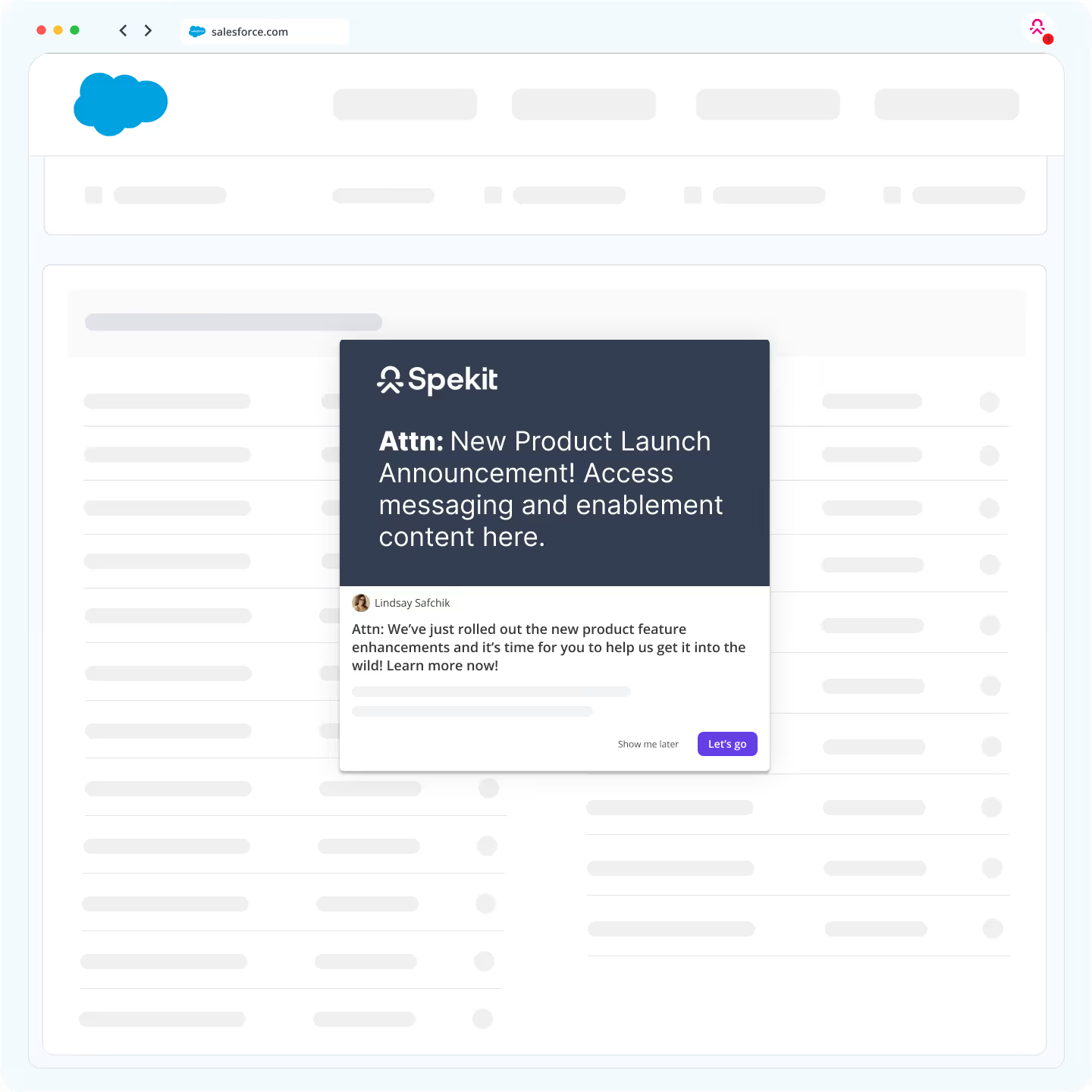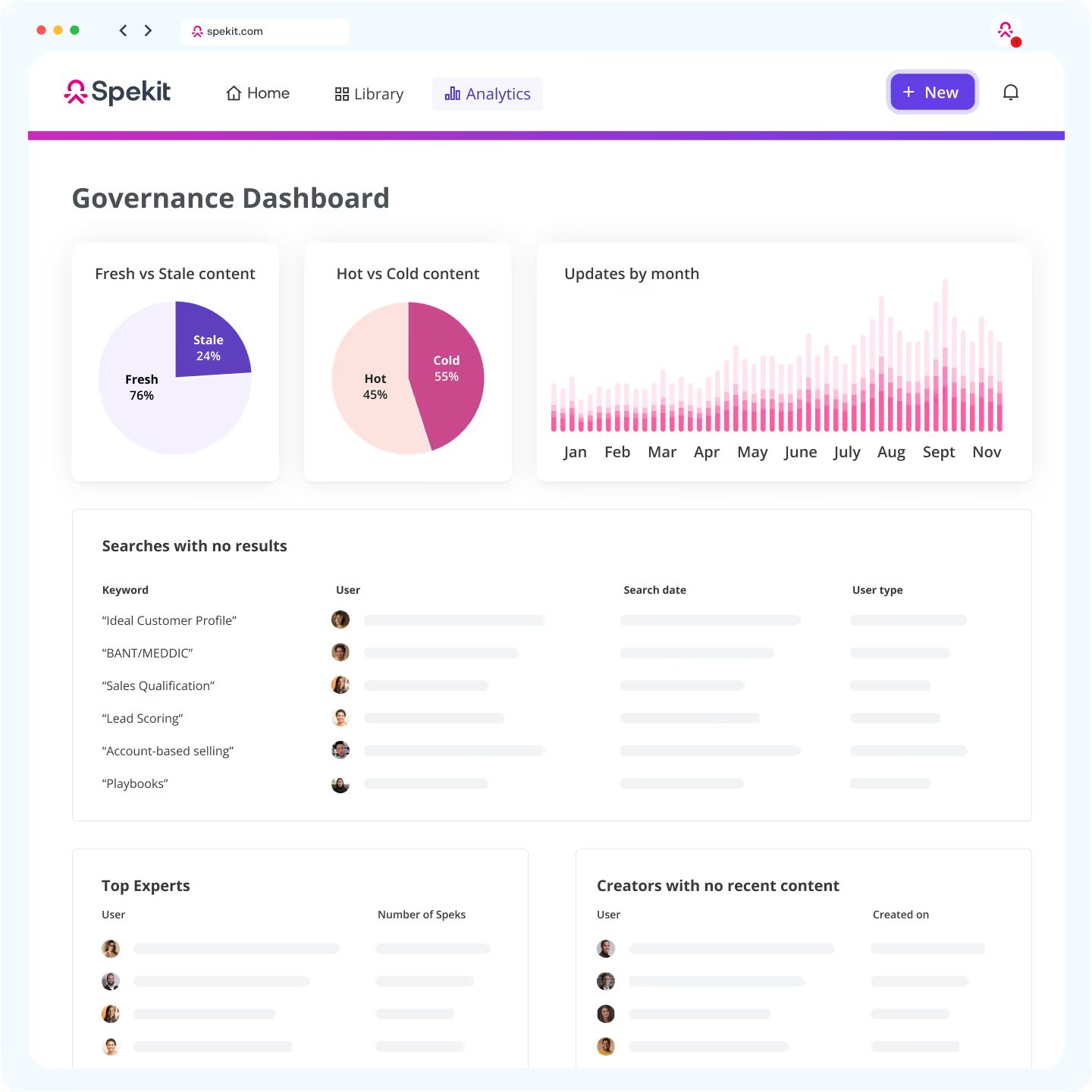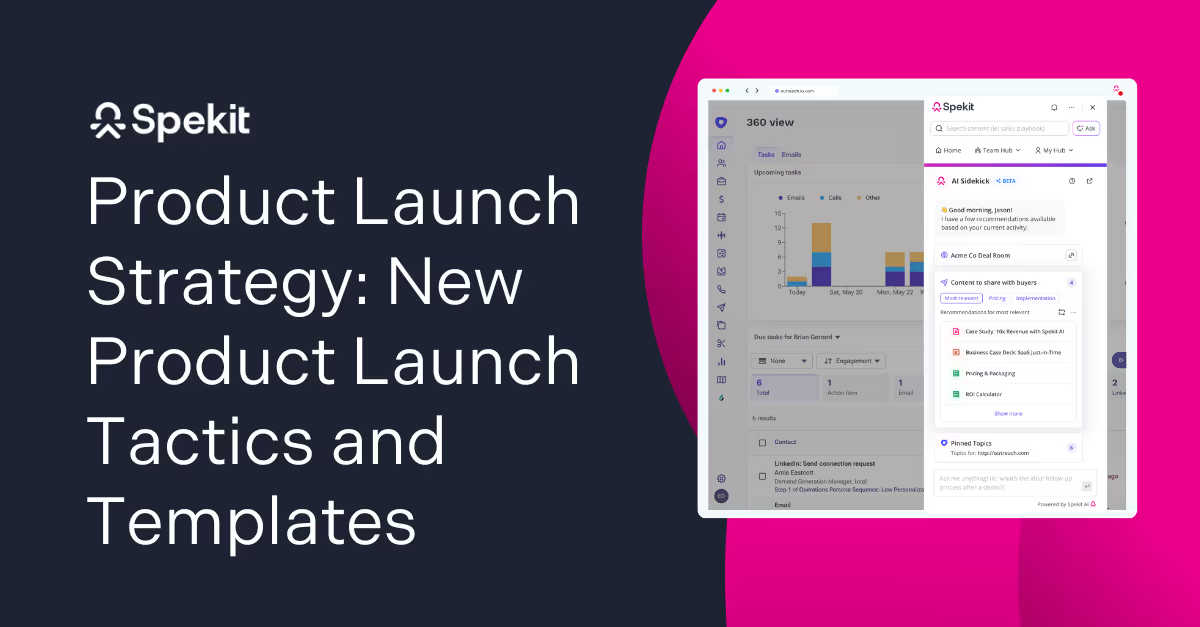Strategy is one of those words that gets applied loosely and without common understanding. What one person thinks is a strategy might actually be a plan.
Which is a shame because this confusion leads to ineffective launches. So in this guide, we’re setting the record straight.
We’ll break down:
- exactly what a product launch strategy is (and isn’t)
- why so many launches fail
- how to build a strategy that leads to actual adoption
You’ll also get a six-step framework and a customizable template to guide your next launch.
What is a product launch strategy?
A product launch strategy is the high-level, directional thinking behind a launch. It defines:
- What you're launching
- Why it matters (to the business and your audience)
- Who it’s for (your target segments)
- How you want to position it in the market
It’s not your launch plan. Because a plan is all about execution: deadlines, stakeholder responsibilities, comms, and sales assets. You’ll need one of those too but not until your strategy is in place.
When building your product launch strategy you’ll start by answering these questions:
- What makes this product valuable?
- How do we explain that value to our audience in a way that sticks?
- How do we ensure sales readiness so our reps can pitch the new product with confidence and clarity and convince people to buy?
Your answers shape everything that comes next, from positioning and pricing to sales readiness and customer communication.
Why do product launches fail?
You've spent weeks or even months planning a product launch, and then, it’s crickets. Customers try it once and abandon it, or reps don't even bring it up in sales calls.
That's the sad reality of 95% of new products. But why exactly does this happen?
1. Poor market research:
Even well-executed launches can fail when the fundamental premise—that customers need and want this solution—turns out to be wrong. Without proper research, you might solve a problem that doesn't really exist, target the wrong audience, or misunderstand how customers actually make purchasing decisions.
2. Poor sales readiness:
Sales reps can't find launch materials buried in shared drives, or discover that enablement content exists only after a customer call. Even when they know where to look, switching between selling and searching for information kills their momentum.
So, they end up winging it with outdated messaging or skip pitching new features entirely.
3. Poor launch timing:
You launch before crucial features are ready because you promised the market a date. Early adopters try your product, find core features missing, and never come back. Or worse, you rush features to meet artificial deadlines, leading to a poor product experience that damages customer trust.
A product launch strategy is your best defense against launch failure. Here’s why:
Each of the pitfalls above may look like execution problems. But more often than not, they’re the result of a missing or misaligned product launch strategy.
That means a well-thought-out strategy is your best defense against failure and your best chance at keeping your launch out of the 95%. Because…
Strategy prevents misalignment
"Literally nothing matters if the team isn't aligned,” says Jon Pipek, Founder of Blue Manta Consulting – a go-to marketing consulting company.
When teams don’t have a shared understanding of who the product is for or why it matters, they default to their own priorities:
- Product builds based on roadmap goals.
- Marketing writes to the masses.
- Sales says whatever will close the deal (whether or not your product can deliver).
Strategy brings everyone onto the same page, aligning on audience, message, and value, so every function reinforces the same story and builds in the same direction.
Strategy clarifies priorities and trade-offs
Ever sit in a meeting and leave with a whole host of to-dos that delay what you should really be doing?
That’s because without a strategic lens, everything feels important—every feature, every message, every stakeholder request. That leads to bloat, delays, and diluted impact.
A defined strategy gives you a filter. If a task doesn’t support your goal, audience, or positioning, it’s out. This focus keeps launches lean, timely, and effective.
Strategy drives stronger messaging and enablement
Reps can’t sell what they don’t understand and they won’t use materials they don’t trust.
Strategy grounds your enablement content in a clear, compelling narrative:
- the problem you're solving
- the outcome you deliver
- why it matters now
With a tool like Spekit, you can surface that story directly in your sales teams’ workflow, turning strategy into in-the-moment sales confidence.
Strategy sets up better measurement and iteration
When you skip strategy, you skip defining what success looks like. That makes it nearly impossible to evaluate whether your launch worked or how to improve.
A good strategy ties business outcomes to launch metrics from the start, making it easier to assess adoption, spot gaps, and adjust your approach over time.
How to create a product launch strategy in 6 steps
Your product launch strategy doesn’t need to be a novel. But it does need to give your team the clarity to make smart decisions, move fast, and stay aligned from kickoff to launch day.
Here’s a practical framework you can use to create a strategy that drives adoption and revenue when it comes time to press ‘Go Live’.
Step 1: Set your goal
Get clear on why you're launching the product in the first place. Product launches aren't always about acquiring new customers. Sometimes it's fixing a bug to reduce churn or delivering a feature to help CS upsell existing accounts.
Without a clear goal, scope creep is inevitable. You'll start focusing on one customer segment, then find Sales pitching to a completely different audience, the product wasn't designed for.
Here's how to set a product launch goal:
- Start with the business context: What's the main business problem you're solving right now? New market entry? Customer retention? Revenue growth?
- Choose your main objective: New customer acquisition, existing customer revenue, churn reduction, market expansion, or satisfaction improvement.
- Turn it into specific numbers with a timeline: For example, 25% adoption among existing customers within 90 days instead of "increase adoption.”
- Match your launch type: A major feature should have awareness/trial goals, while bug fixes should have retention goals.
- Align with product stage: As an early-stage product, you should prioritize learning and feedback, while a more mature product might focus on market share or revenue targets.
Once you've set your goal, it becomes easier to set KPIs for measuring success and choose the right stakeholders to collaborate with. For example, if you're shipping a bug fix to reduce churn, Sales might not be a primary stakeholder because they're focused on acquiring new customers, not retaining existing ones.
Your key collaborators would be Customer Success (who sees the churn impact), Product (who understands the technical fix), and Support (who handles customer complaints about the bug).
Step 2. Define your target audience and pain
This information should already be floating around somewhere because no product should be created without first understanding who it's for and what it solves.
But surface-level personas or vague pain points won’t cut it when you’re building your launch strategy. You need to sharpen the picture and align your team around exactly who you’re targeting, what they care about, and why this launch matters to them:
- Are you targeting new prospects or existing customers?
- Are you focusing on a specific industry, company size, or persona?
- Is your primary buyer the user, the manager, or the exec?
Be as specific as possible. If the audience is “anyone in revenue,” your messaging and enablement will end up scattered and ineffective.
Then, zoom in on the friction, inefficiencies, or missed opportunities your product addresses. Ask:
- What’s frustrating or broken in their current process?
- What’s costing them time, money, or credibility?
- What’s at stake if they don’t act?
This is all to prepare you for writing up messaging that makes your product feel like medicine for their pains, not a vitamin.
Step 3. Craft your positioning and messaging
Wait a minute… this step feels like execution, not strategy.
You’re right. But, your messaging is the bridge between the product you built and the people you built it for. It determines whether Sales has a clear pitch, whether Marketing knows what to say, and whether your audience feels like this product was made for them.
So, it is strategy. It’s the work of translating insight into influence. You need to educate customers and the people within your organization about why the product exists and how it benefits them.
As Derek Osgood, CEO of Ignition, explains,
“A successful product launch is not just about customers knowing that the product exists. Everyone else within the company should know it exists, too—and more importantly, how to talk about it. They should know how to promote the product to future customers.”
For internal messaging, build this three-part structure:
- Business impact statement: This [product/feature] will [specific outcome] for [specific segment], driving [measurable result]
Example: Our new analytics dashboard will help enterprise customers reduce reporting time by 40%, increasing our expansion revenue by $2M this year.
- Why now statement: Market change + Customer pain + Our solution
Example: Rising data privacy concerns + Customer struggles with compliance + Our automated GDPR tools = Perfect timing for launch"
- One-line value prop for meetings: We help [customer] achieve [outcome] by [unique approach]
Example: We help sales teams close deals faster by bringing enablement content directly into their workflow.
For external messaging:
- Transform features into outcomes.
Instead of: AI-powered content recommendations
Write: Get the exact sales materials you need, right when you're talking to customers.
- Back every claim with specific proof points
Instead of: Saves time
Write: Sales reps save 5 hours per week by eliminating content searches
Step 4: Align and activate stakeholders
In step one you identified your primary stakeholders. Now it’s time to schedule a 30-minute pre-kickoff strategy meeting. The goal: align on why the launch matters, what success looks like, and who’s doing what.
Then, document stakeholder roles using the DACI framework:
- Driver: Owns the launch execution (typically Product Marketing)
- Approver: Signs off on key decisions (e.g., CMO, Head of Product)
- Contributors: Actively execute parts of the plan (Sales, CS, Product)
- Informed: Need visibility into status or timing (Support, RevOps, Leadership)
Here's how Nicole Wight, Senior Director of Product Marketing and Revenue Enablement at AudioEye, uses a DACI template for stakeholder alignment.
“Before I do any big documentation, I use a Go-to-Market template that I've built in line with what works for our company. It's basically a table that follows the DACI model (Driver, Approver, Contributor, Informed) and lists those people and their roles. They have to sign off and review it with a date. Then, make sure your approvers are involved in the launch from Day One and carried along for early feedback.”
Step 5: Determine what sales enablement assets you’ll need and how you’ll go to market
About 41% of launches are measured purely on revenue growth. That means leadership doesn't care about your fancy metrics—they want to see the new product or feature adding to the bottom line.
Since you're not a salesperson, your best bet to meet your revenue target is to equip your sales reps with product knowledge and context to help them explain value to customers, handle pricing objections, and close deals faster.
That starts with defining your enablement strategy.
At a minimum, identify:
- What product knowledge gaps need to be filled?
- What buyer objections will reps need to handle?
- What’s the simplest story that connects this product to the customer’s pain?
From there, outline the core asset types your team will need. For example:
- A product sheet that outlines key features, benefits, and the target customer profile
- Battle cards with competitor comparisons and objection handling
- Talk tracks for different customer personas and use cases
“One of the big mistakes that a lot of companies make is they assume that Sales and other teams are going to come and find enablement information,” says Derek.
“They'll drop it in some source of truth, whether it's like a bunch of docs or it's a single doc, and then they'll just say, hey, this stuff here, come find it if you want it. And the reality is most of those teams will never go find it.”
So, when it comes time to distribute these sales assets, take advantage of product marketing software like Spekit that specializes in contextual content delivery. It surfaces enablement content directly in the tools your teams already use, like Salesforce and Slack.
You can also create Playlists in Spekit featuring all the resources a rep needs for the product rollout—case studies, videos, one-pagers, so they can find all sales enablement resources in one place.
Even better, Spekit AI can help repurpose your launch messaging into sales-ready assets like talk tracks, objection handling, or product summaries. That way, your strategy turns into tailored content faster, and nothing gets lost in translation between teams.

Step 6: Define your success metrics
Most launches end with the same question: “Did it work?”
The problem is, that question usually gets asked after launch day and answered with a vague nod to revenue, retention, or rep feedback. By that point, it's too late to shape the outcome.
A smarter approach is to define success from the start.
Begin by revisiting your launch goal. If you’re aiming for new logo acquisition, your metrics should track pipeline creation, trial signups, or conversion velocity. If your goal is retention, look for indicators like reduced churn, feature adoption among at-risk accounts, or support ticket volume.
Make it specific. Replace fuzzy metrics like “awareness” or “engagement” with numbers and timeframes:
- 500 trial signups in 30 days
- 25% increase in usage among target accounts
- 75% rep adoption of the new talk track within 14 days
Make it visible. Use tools like Spekit to track engagement with enablement content—which battlecards are being viewed, which Spotlights are clicked, which Playlists actually get used. If reps aren’t consuming the content, they’re probably not using the messaging.

Make it iterative. Pair quantitative data with qualitative input. Shadow sales calls. Run quick rep surveys. Capture customer reactions. Then, feed those insights back into your next launch strategy.
Need inspiration on how to use a tool like Spekit to track asset adoption and pipeline development post launch? Check out our resource: How to Measure Sales Enablement Success & 31 Sales Enablement Metrics
Product launch strategy template
Use this simplified, adaptable template to align cross-functional teams around the “why,” “who,” and “what” before diving into detailed planning.
Build enablement into your product launch strategy with Spekit
Spekit meets your reps where they are and delivers the exact knowledge they need to sell new products. Instead of waiting for reps to check enablement folders or watch training videos, it surfaces the exact information they need to close a sale or handle a customer objection, when they need it.
This way, your product launch isn’t just another random effort by the team, but actually impacts the business’s bottom line.
Ready to see how Spekit empowers sales readiness for high-functioning product teams? Book a demo today.








